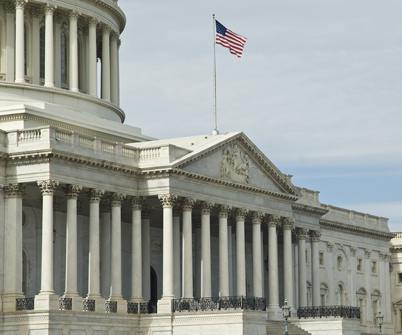PMPA Political Action: What’s at Stake for Your Business?
PMPA is involved and working to minimize their negative impact on your shop. Here is a quick review of a few of them.
The PMPA is active on a number of issues in Washington that can have a major impact on your shop. Whether it’s rules coming from the Department of Labor, National Labor Relations Board, U.S. EPA, legislation from Capitol Hill or cases before the U.S. Supreme Court, PMPA is involved and working to minimize their negative impact on your shop. Here is a quick review of a few of them.
What We Face
Featured Content
With the passing of Supreme Court Justice Antonin Scalia, the evenly divided court puts a number of issues in play. As a result of 4-4 ties, lower court decisions stand. Four days before Justice Scalia passed, an already divided court held in our favor 5-4, forcing the EPA to halt work on its controversial power plant rule, which was expected to increase electricity costs by 6 to 20 percent, annually. A lower court is considering the case this month, but isexpected to rule against manufacturers and a 4-4 Supreme Court is powerless to step in.
A similar fate could play out for the “Waters of the United States” rule where the EPA is trying to expand its reach over inland waterways from 3 million miles to more than 8 million, an unprecedented land grab that could impact thousands of manufacturers with increased costs, paperwork and penalties.
What We’re Working On
Trichloroethylene (TCE): New TCE regulations are being promulgated for proposal by USEPA, and PMPA is involved in the small business review phase. TCE is used in vapor degreasing applications and is irreplaceable for a number of highly technical applications requiring the best in cleanliness, including glass-to-metal sealing applications, hermetically sealed connectors and many other critical (and often defense-related) uses. Several PMPA members have already provided input, and PMPA and others are planning on attending and providing insight to EPA at their final SBAR meeting.
Ozone rule: Even Mother Nature can’t comply, but that doesn’t stop the regulators at EPA from trying to set ozone standards that will limit your ability to expand the business if your county is not in compliance. The new ozone rules came out only a few months after EPA’s final guidance on the 2008 ozone regulations were issued. Duplicative costs of trying to comply with two standards at once are likely, and an analysis of the data suggests that more than 950 counties nationwide, probably including yours, may become subject to non-attainment controls.
Overtime pay exemptions for executive, administrative and professional employees: In June 2015, the Department of Labor proposed increasing the salary threshold by 113 percent for overtime pay nationwide, regardless of regional economic differences. This proposal also provides for 10 percent automatic increases in the salary threshold on an annual basis. If this goes into effect, a large number of
currently salaried professionals in our industry will lose their salary status and become hourly employees as a result of this rule. Loss of salary status means loss of flexibility for personal errands, school visits and more while on the clock.
What We’ve Won
PMPA has been working diligently for years to try to get some fairness and predictability in the area of small businesstaxes. For the first time since 1986, manufacturers have some level of predictability in the U.S. tax code. The tax bill signed by President Obama last December includes the following provisions:
• Permanent 14-percent ASC R&D with AMT claim: This provision extends R&D tax credit for 2015; starting in 2016, the base R&D credit at 20 percent and the Alternative Simplified R&D at 14 percent are made permanent and allow small businesses ($50 million or less in gross receipts) to claim the credit against their Alternative Minimum Tax (AMT) liability. This will help our shops modernize their technology and upgrade employee skills.
• Permanent Section 179 equipment expensing: Extends Section 179 for 2015 restored to $500,000
with a $2 million phase-out indexed to infl ation starting in 2016. Also treats air conditioning and heating units placed in service beginning after 2015 as eligible for expensing. This will help us thoughtfully plan our investments for job creation.
• Extends bonus depreciation through 2019 with AMT claim: Extends from January 1, 2015, through
2019 bonus depreciation with an additional year for certain property with a longer production period.
The depreciation percentage is 50 percent for property placed in service during 2015, 2016 and 2017 and phases down, with 40 percent in 2018 and 30 percent in 2019. The provision continues to allow taxpayers to elect to accelerate the use of AMT credits in lieu of bonus depreciation for property
placed in service during 2015 and beginning in 2016 and increases the amount of unused AMT credits
a taxpayer may claim in lieu of a bonus. Again, more jobs will be created as a result of increased
investments made possible by this.
• Two-year moratorium on medical device excise tax: The measure suspends, for all of 2016 and 2017, the 2.3-percent excise tax imposed on the sale of medical devices under the Affordable Care Act. It is no secret that medical markets are an important sector for our precision machining shops. The excise tax had depressed demand for medical components. This moratorium should help the medical device markets rebound.
• Commercial building energy efficiency deduction extended: Extends through 2016 the above-the line deduction for energy effi ciency improvements to lighting, heating, cooling, ventilation and hot
water systems of commercial buildings. The money saved by energy savings is money that can be used
to purchase new equipment and hire and train new employees.
• Extends hiring long-term unemployed credit: Extends through 2019 the work opportunity tax
credit and beginning in 2016, allows employers who hire qualifi ed long-term unemployed individuals
(27 weeks or more) to claim up to 40 percent of the first $6,000 of wages paid. Our shops need a skilled
and talented workforce. This incentive to hire the long-term unemployed makes it an easier decision
to invest in training to help these people return to long-term fi nancial prosperity with a career in our
precision machining industry. Our employment sentiment is consistently positive. This can help us
help those who need a chance.
There is no doubt that our shops face higher levels of regulatory uncertainty now than ever before. We continue to see hostility in emerging policies and regulations from the federal agencies. But PMPA’s active role in government affairs has led to successes that have given us more clarity, more predictability and a better opportunity to plan for our businesses. Government affairs and lobbying are probably not high on your personal list of priorities in today’s ambiguous and unsettling markets, but the government costs you money every day. PMPA is involved in Washington to help your shop better adapt and thrive with the regulatory challenges we all face.







